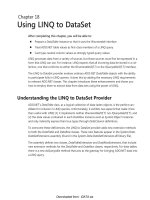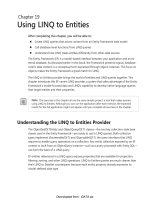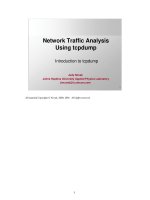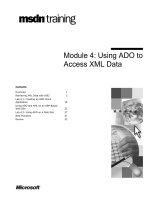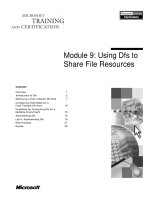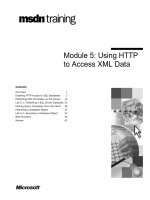practical packet analysis - using wireshark to solve real-world network problems
Bạn đang xem bản rút gọn của tài liệu. Xem và tải ngay bản đầy đủ của tài liệu tại đây (11.49 MB, 194 trang )
It’s easy enough to install Wireshark and begin capturing
packets off the wire—or from the air. But how do you
interpret those packets once you’ve captured them? And
how can those packets help you to better understand
what’s going on under the hood of your network?
Practical Packet Analysis shows how to use Wireshark
to capture and then analyze packets as you take an in-
depth look at real-world packet analysis and network
troubleshooting. The way the pros do it.
Wireshark (derived from the Ethereal project), has
become the world’s most popular network sniffing appli-
cation. But while Wireshark comes with documentation,
there’s not a whole lot of information to show you how
to use it in real-world scenarios. Practical Packet Analysis
shows you how to:
• Use packet analysis to tackle common network
problems, such as loss of connectivity, slow networks,
malware infections, and more
• Build customized capture and display filters
• Tap into live network communication
www.nostarch.com
“ I L AY FLAT .”
This book uses RepKover—a durable binding that won’t snap shut.
Printed on recycled paper
TH E F I N E S T I N G E E K E NT E RTAI N M E NT
™
SHELVE IN:
NETWORKING/SECURITY
$39.95 ($49.95 CDN)
®
D O N ’ T J U S T S T A R E
A T C A P T U R E D
P A C K E T S .
A N A L Y Z E T H E M .
D O N ’ T J U S T S T A R E
A T C A P T U R E D
P A C K E T S .
A N A L Y Z E T H E M .
• Graph traffic patterns to visualize the data flowing
across your network
• Use advanced Wireshark features to understand
confusing packets
• Build statistics and reports to help you better explain
technical network information to non-technical users
Because net-centric computing requires a deep under-
standing of network communication at the packet level,
Practical Packet Analysis is a must have for any network
technician, administrator, or engineer troubleshooting
network problems of any kind.
A B O U T T H E A U T H O R
Chris Sanders is the network administrator for the
Graves County Schools in Kentucky, where he
manages more than 1,800 workstations, 20 servers,
and a user base of nearly 5,000. His website,
ChrisSanders.org, offers tutorials, guides, and
technical commentary, including the very popular
Packet School 101. He is also a staff writer for
WindowsNetworking.com and WindowsDevCenter.com.
He uses Wireshark for packet analysis almost daily.
T E C H NI C A L R E V I E W B Y G E R A L D C O M B S, C R E A T O R O F W I R E S H A R K
T E C H N I C A L R E V I E W B Y G E R A L D C O M B S , C R E A T O R O F W I R E S H A R K
Download the capture files
used in this book from
www.nostarch.com/packet.htm
PR AC T IC A L
PACKE T A N A LYSIS
PR AC T IC A L
PACKE T A N A LYSIS
U S I N G W I R E S H A R K T O S O L V E R E A L - W O R L D
N E T W O R K P R O B L E M S
C H R I S S A N D E R S
®
P R A C T I C A L PAC K E T A N A LY S I S
P R A C T I C A L PAC K E T A N A LY S I S
S A N D E R S
PRACTICAL PACKET ANALYSIS
PRACTICAL PACKET
ANALYSIS
Using Wireshark to Solve
Real-World Network
Problems
by Chris Sanders
San Francisco
®
PRACTICAL PACKET ANALYSIS. Copyright © 2007 by Chris Sanders.
All rights reserved. No part of this work may be reproduced or transmitted in any form or by any means, electronic or
mechanical, including photocopying, recording, or by any information storage or retrieval system, without the prior
written permission of the copyright owner and the publisher.
11 10 09 08 07 1 2 3 4 5 6 7 8 9
ISBN-10: 1-59327-149-2
ISBN-13: 978-1-59327-149-7
Publisher: William Pollock
Production Editor: Christina Samuell
Cover and Interior Design: Octopod Studios
Developmental Editor: William Pollock
Technical Reviewer: Gerald Combs
Copyeditor: Megan Dunchak
Compositor: Riley Hoffman
Proofreader: Elizabeth Campbell
Indexer: Nancy Guenther
For information on book distributors or translations, please contact No Starch Press, Inc. directly:
No Starch Press, Inc.
555 De Haro Street, Suite 250, San Francisco, CA 94107
phone: 415.863.9900; fax: 415.863.9950; ; www.nostarch.com
Library of Congress Cataloging-in-Publication Data
Sanders, Chris, 1986-
Practical packet analysis : using Wireshark to solve real-world network problems / Chris Sanders.
p. cm.
ISBN-13: 978-1-59327-149-7
ISBN-10: 1-59327-149-2
1. Computer network protocols. 2. Packet switching (Data transmission) I. Title.
TK5105.55.S265 2007
004.6'6 dc22
2007013453
No Starch Press and the No Starch Press logo are registered trademarks of No Starch Press, Inc. Other product and
company names mentioned herein may be the trademarks of their respective owners. Rather than use a trademark
symbol with every occurrence of a trademarked name, we are using the names only in an editorial fashion and to the
benefit of the trademark owner, with no intention of infringement of the trademark.
The information in this book is distributed on an “As Is” basis, without warranty. While every precaution has been
taken in the preparation of this work, neither the author nor No Starch Press, Inc. shall have any liability to any
person or entity with respect to any loss or damage caused or alleged to be caused directly or indirectly by the
information contained in it.
Printed on recycled paper in the United States of America
This book is dedicated to my parents, who bought
the first computer I ever programmed.
BRIEF CONTENTS
Acknowledgments xv
Introduction xvii
Chapter 1: Packet Analysis and Network Basics 1
Chapter 2: Tapping into the Wire 15
Chapter 3: Introduction to Wireshark 27
Chapter 4: Working with Captured Packets 39
Chapter 5: Advanced Wireshark Features 51
Chapter 6: Common Protocols 61
Chapter 7: Basic Case Scenarios 77
Chapter 8: Fighting a Slow Network 99
Chapter 9: Security-based Analysis 121
Chapter 10: Sniffing into Thin Air 135
Chapter 11: Further Reading 151
Afterword 154
Index 155
CONTENTS IN DETAIL
ACKNOWLEDGMENTS xv
INTRODUCTION xvii
Why This Book? xviii
Concepts and Approach xviii
How to Use This Book xx
About the Example Capture Files xx
1
PACKET ANALYSIS AND NETWORK BASICS 1
What Is Packet Analysis? 2
Evaluating a Packet Sniffer 2
Supported Protocols 2
User Friendliness 2
Cost 3
Program Support 3
Operating System Support 3
How Packet Sniffers Work 3
Collection 3
Conversion 3
Analysis 3
How Computers Communicate 4
Networking Protocols 4
The Seven-Layer OSI Model 4
Protocol Interaction 6
Data Encapsulation 7
The Protocol Data Unit 8
Network Hardware 8
Traffic Classifications 12
2
TAPPING INTO THE WIRE 15
Living Promiscuously 16
Sniffing Around Hubs 16
Sniffing in a Switched Environment 18
Port Mirroring 18
Hubbing Out 19
ARP Cache Poisoning 20
Using Cain & Abel 21
Sniffing in a Routed Environment 24
Network Maps 25
x Contents in Detail
3
INTRODUCTION TO WIRESHARK 27
A Brief History of Wireshark 27
The Benefits of Wireshark 28
Supported Protocols 28
User Friendliness 28
Cost 28
Program Support 28
Operating System Support 29
Installing Wireshark 29
System Requirements 29
Installing on Windows Systems 29
Installing on Linux Systems 31
Wireshark Fundamentals 31
Your First Packet Capture 31
The Main Window 33
The Preferences Dialog 34
Packet Color Coding 35
4
WORKING WITH CAPTURED PACKETS 39
Finding and Marking Packets 39
Finding Packets 40
Marking Packets 40
Saving and Exporting Capture Files 41
Saving Capture Files 41
Exporting Capture Data 42
Merging Capture Files 42
Printing Packets 43
Time Display Formats and References 43
Time Display Formats 43
Packet Time Referencing 44
Capture and Display Filters 45
Capture Filters 45
Display Filters 46
The Filter Expression Dialog (the Easy Way) 47
The Filter Expression Syntax Structure (the Hard Way) 47
Saving Filters 49
5
ADVANCED WIRESHARK FEATURES 51
Name Resolution 51
Types of Name Resolution Tools in Wireshark 52
Enabling Name Resolution 52
Potential Drawbacks to Name Resolution 52
Protocol Dissection 53
Following TCP Streams 55
The Protocol Hierarchy Statistics Window 56
Contents in Detail xi
Viewing Endpoints 57
Conversations 58
The IO Graphs Window 59
6
COMMON PROTOCOLS 61
Address Resolution Protocol 62
Dynamic Host Configuration Protocol 62
TCP/IP and HTTP 64
TCP/IP 64
Establishing the Session 64
Beginning the Flow of Data 66
HTTP Request and Transmission 66
Terminating the Session 67
Domain Name System 68
File Transfer Protocol 69
CWD Command 70
SIZE Command 70
RETR Command 71
Telnet Protocol 71
MSN Messenger Service 72
Internet Control Message Protocol 75
Final Thoughts 75
7
BASIC CASE SCENARIOS 77
A Lost TCP Connection 77
Unreachable Destinations and ICMP Codes 79
Unreachable Destination 79
Unreachable Port 80
Fragmented Packets 81
Determining Whether a Packet Is Fragmented 81
Keeping Things in Order 82
No Connectivity 83
What We Know 84
Tapping into the Wire 84
Analysis 84
Summary 86
The Ghost in Internet Explorer 86
What We Know 86
Tapping into the Wire 86
Analysis 87
Summary 88
Inbound FTP 88
What We Know 88
Tapping into the Wire 88
Analysis 88
Summary 90
xii Contents in Detail
It’s Not My Fault! 90
What We Know 90
Tapping into the Wire 90
Analysis 90
Summary 92
An Evil Program 92
What We Know 92
Tapping into the Wire 92
Analysis 93
Summary 97
Final Thoughts 98
8
FIGHTING A SLOW NETWORK 99
Anatomy of a Slow Download 100
A Slow Route 104
What We Know 104
Tapping into the Wire 104
Analysis 105
Summary 106
Double Vision 107
What We Know 107
Tapping into the Wire 107
Analysis 107
Summary 109
Did That Server Flash Me? 109
What We Know 109
Tapping into the Wire 109
Analysis 110
Summary 111
A Torrential Downfall 111
What We Know 111
Tapping into the Wire 111
Analysis 112
Summary 113
POP Goes the Email Server 114
What We Know 114
Tapping into the Wire 114
Analysis 114
Summary 115
Here’s Something Gnu 115
What We Know 116
Tapping into the Wire 116
Analysis 116
Summary 119
Final Thoughts 119
Contents in Detail xiii
9
SECURITY-BASED ANALYSIS 121
OS Fingerprinting 121
A Simple Port Scan 122
The Flooded Printer 123
What We Know 123
Tapping into the Wire 123
Analysis 123
Summary 124
An FTP Break-In 124
What We Know 125
Tapping into the Wire 125
Analysis 125
Summary 127
Blaster Worm 127
What We Know 127
Tapping into the Wire 127
Analysis 127
Summary 128
Covert Information 129
What We Know 129
Tapping into the Wire 129
Analysis 129
Summary 130
A Hacker’s Point of View 130
What We Know 130
Tapping into the Wire 131
Analysis 131
Summary 133
10
SNIFFING INTO THIN AIR 135
Sniffing One Channel at a Time 135
Wireless Signal Interference 136
Wireless Card Modes 136
Sniffing Wirelessly in Windows 138
Configuring AirPcap 138
Capturing Traffic with AirPcap 140
Sniffing Wirelessly in Linux 141
802.11 Packet Extras 142
802.11 Flags 143
The Beacon Frame 143
Wireless-Specific Columns 144
Wireless-Specific Filters 145
Filtering Traffic for a Specific BSS Id 146
Filtering Specific Wireless Packet Types 146
Filtering Specific Data Types 146
xiv Contents in Detail
A Bad Connection Attempt 148
What We Know 148
Tapping into the Wire
Air 148
Analysis 148
Summary 150
Final Thoughts 150
11
FURTHER READING 151
AFTERWORD 154
INDEX 155
ACKNOWLEDGMENTS
First and foremost, I would like to thank God for
giving me the strength and fortitude it took to com-
plete this project. When my to-do list grew longer and
longer and there was no end in sight, he was the one
who helped me through all of the stressful times.
I want to thank Bill, Tyler, Christina, and the rest of the team at No Starch
Press for giving me the opportunity to write this book and allowing me the
creative freedom to do it my way. I would also like to thank Gerald Combs for
having the drive and motivation to maintain the Wireshark program, as well
as perform the technical edit of this book. Special thanks go out to Laura
Chappell, as well, for providing some of the best packet analysis training
materials you will find, including several of the packet captures used here.
Personally speaking, I would like to thank Tina Nance, Eddy Wright, and
Paul Fletcher for helping me along the path that has led me to this high point
in my career. You guys have been great spiritual and professional mentors as
well as great friends. Along with that, I have several amazing friends who
managed to put up with me while I was writing this book, which is an
xvi Acknowledgments
accomplishment in itself. I would like to extend a very special thank you to
Mandy, Barry, Beth, Chad, Jeff, Sarah, and Brandon. I couldn’t have done
it without you guys behind me.
Mostly, however, I want to thank my loving parents, Kenneth and Judy
Sanders. Dad, even though you have never laid hands on a computer, your
constant support and nurturing is the reason all of this was possible. Nothing
makes me more driven than the desire to hear you say that you are proud of
me. Mom, you have been gone from us for five years as of the writing of this
book, and although you couldn’t be around to see this achievement, you are
always in my heart, and that is my true driving force. The passion you showed
for living life is what has inspired me to be so passionate in what I do. This
book is every bit as much your accomplishment as it is mine.
INTRODUCTION
I got my first computer when I was nine years old.
As things go with technology, it broke within about a
year. It was enough of a stretch for my family to afford
a computer in the first place, and paying for it to be
fixed was just financially impossible. However, after
a little reading and experimentation, I fixed the com-
puter myself, and that’s where my interest in technology
began.
That interest evolved into a passion through high school and college, and
as that passion grew, so did my abilities, naturally leading me to situations in
which I really needed to dig further into network and computer problems.
This is when I stumbled upon the Wireshark project (it was called Ethereal at
the time). This software allowed me to enter a completely new world. Being
able to analyze problems in new ways and having the ability to see raw
protocols on the wire gave me limitless power in computer and network
troubleshooting.
xviii Introduction
The great thing about packet analysis is that it has become an increasingly
popular method of solving problems and learning more about networks.
Thanks to the advent of user groups, wikis, and blogs, the techniques
covered in this book are becoming prerequisite knowledge for some jobs.
Packet analysis is a requirement for managing today’s networks, and this
book will give you the jump start you need in learning how it all works.
Why This Book?
You may find yourself wondering why you should buy this book as opposed
to any other book about packet analysis. The answer lies right in the title:
Practical Packet Analysis. Let’s face it—nothing beats real-world experience,
and the closest you can come to that experience in a book is through practical
examples of packet analysis with real-world case scenarios. The first half of
this book gives you the prerequisite knowledge you will need to understand
packet analysis and Wireshark. The second half of the book is devoted
entirely to practical case scenarios that you could easily encounter in day-
to-day network management.
Whether you are a network technician, a network administrator, a chief
information officer, a desktop technician, or simply a help desk worker, you
have a lot to gain from understanding and using packet analysis techniques.
Concepts and Approach
I am generally a really laid-back guy, so I when I teach a concept, I try to do so
in a really laid-back way. This holds true for the language used in this book.
It is very easy to get lost in technical jargon when dealing with a technical
concept, but I have tried my best to keep things as casual as possible. I’ll
make all definitions clear, straightforward, and to the point, without any
added fluff.
If you really want to learn packet analysis, you should make it a point
to master the concepts in the first several chapters—they are integral to
understanding the rest of the book. The second half of the book is purely
conceptual. You may not see these exact scenarios in your work, but you
should be able to apply the concepts you learn from them in the situations
you do encounter.
Here is a quick breakdown of the chapters of this book.
Chapter 1: Packet Analysis and Network Basics
What is packet analysis? How does it work? How do you do it? This chap-
ter covers the very basics of network communication and packet analysis.
Chapter 2: Tapping into the Wire
This chapter covers the different techniques you can use to place a packet
sniffer on your network.
Introduction xix
Chapter 3: Introduction to Wireshark
Here we’ll look at the basics of Wireshark—where to get it, how to use it,
what it does, why it’s great, and all of that good stuff.
Chapter 4: Working with Captured Packets
Once you get Wireshark up and running, you will want to know the
basics of interacting with captured packets. This is where you’ll learn.
Chapter 5: Advanced Wireshark Features
Once you have learned to crawl, it’s time to take off running with the
advanced Wireshark features. This chapter delves into these features and
goes under the hood to show you things that aren’t always so apparent.
Chapter 6: Common Protocols
This chapter shows what some of the most common network communi-
cation protocols look like at the packet level. In order to understand
how these protocols can malfunction, you first have to understand how
they work.
Chapter 7: Basic Case Scenarios
This chapter contains the first set of real-world case scenarios. Each
scenario is presented in an easy-to-follow format, where for each scenario
the problem, my analysis, and a solution are given. These basic scenarios
deal with only a few computers and involve a limited amount of analysis—
just enough to get your feet wet.
Chapter 8: Fighting a Slow Network
The most common problems network technicians hear about generally
involve slow network performance. This chapter is devoted to solving
these types of problems.
Chapter 9: Security-based Analysis
Network security is the biggest hot-button topic in network administration.
Because of this, Chapter 9 shows you the ins and outs of solving security-
related issues with packet analysis techniques.
Chapter 10: Sniffing into Thin Air
The last chapter of the practical section of the book is a primer on wire-
less packet analysis. This chapter discusses the differences between wireless
analysis and wired analysis and includes a quick case scenario that rein-
forces what you’ve learned.
Chapter 11: Further Reading
The final chapter of the book sums up what you have learned and
includes some other reference tools and websites you might find useful
as you continue to use the packet analysis techniques you have learned.
xx Introduction
How to Use This Book
I have intended this book to be used in two ways. The first is, of course, as
an educational text that you will read through, chapter by chapter, in order
to gain an understanding of packet analysis. This means paying particular
attention to the real-world scenarios in the last several chapters. The other use
of this book is as a reference resource. There are some features of Wireshark
that you will not use very often, so you may forget how they work. Because of
this, Practical Packet Analysis is a great book to have on your bookshelf should
you need a quick refresher about how to use a specific feature.
About the Example Capture Files
All of the capture files used in this book are available at tarch
.com/packet.htm. In order to maximize the potential of this book, I would
highly recommend you download these files and use them as you follow
along with the book.
Several of these capture files were contributed by Laura Chappell of the
Packet Analysis Institute and Wireshark University. Those captures are as
follows:
blaster.pcap gnutella.pcap
destunreachable.pcap hauntedbrowser.pcap
dosattack.pcap http-client-refuse.pcap
double-vision.pcap http-fault-post.pcap
email-troubles.pcap icmp-tracert-slow.pcap
evilprogram.pcap osfingerprinting.pcap
ftp-crack.pcap slowdownload.pcap
ftp-uploadfailed.pcap tcp-con-lost.pcap
1
PACKET ANALYSIS AND
NETWORK BASICS
A million different things can go wrong
with a computer network on any given
day—from a simple spyware infection to a
complex router configuration error—and it
is impossible to solve every problem immediately. The
best we can hope to do is be fully prepared with the
knowledge and the tools it takes to respond to these types of issues. All net-
work problems stem from the packet level, where even the prettiest-looking
applications can reveal their horrible implementations and seemingly trust-
worthy protocols can prove malicious. To better understand and solve network
problems, we go to the packet level where nothing is hidden from us, where
nothing is obscured by misleading menu structures, eye-catching graphics, or
untrustworthy employees. Here there are no secrets, and the more we can do
at the packet level, the more we can control our network and solve problems.
This is the world of packet analysis.
This book dives into the world of packet analysis headfirst. You’ll learn
what packet analysis is before we delve into network communication, so you
can gain some of the basic background you’ll need to examine different
2 Chapter 1
scenarios. You’ll learn how to use the features of the Wireshark packet
analysis tool to tackle slow network communication, identify application
bottlenecks, and even track hackers through some real-world scenarios. By
the time you have finished reading this book, you should be able to imple-
ment advanced packet analysis techniques that will help you solve even the
most difficult problems in your own network.
What Is Packet Analysis?
Packet analysis, often referred to as packet sniffing or protocol analysis, describes
the process of capturing and interpreting live data as it flows across a net-
work in order to better understand what is happening on that network.
Packet analysis is typically performed by a packet sniffer, a tool used to capture
raw network data going across the wire. Packet analysis can help us under-
stand network characteristics, learn who is on a network, determine who or
what is utilizing available bandwidth, identify peak network usage times,
identify possible attacks or malicious activity, and find unsecured and
bloated applications.
There are various types of packet sniffing programs, including both
free and commercial ones. Each program is designed with different goals
in mind. A few of the more popular packet analysis programs are tcpdump
(a command-line program), OmniPeek, and Wireshark (both GUI-based
sniffers).
Evaluating a Packet Sniffer
There are several types of packet sniffers. When selecting the one you’re
going to use, you should consider the following variables:
Supported Protocols
All packet sniffers can interpret various protocols. Most sniffers can interpret
all of the most common protocols such as DHCP, IP, and ARP, but not all can
interpret some of the more nontraditional protocols. When choosing a sniffer,
make sure that it supports the protocols you’re going to use.
User Friendliness
Consider the packet sniffer’s program layout, ease of installation, and general
flow of standard operations. The program you choose should fit your level of
expertise. If you have very little packet analysis experience, you may want to
avoid the more advanced command-line packet sniffers like tcpdump.
On the contrary, if you have a wealth of experience, you may find a more
advanced program to be a better choice.
Supported protocols Program support
User friendliness Operating system support
Cost
Packet Analysis and Network Basics 3
Cost
The great thing about packet sniffers is that there are lots of free ones that
rival any commercial product. You should never have to pay for a packet
sniffing application.
Program Support
Even once you have mastered the basics of a sniffing program, you will
probably still need occasional support to solve new problems as they arise.
When evaluating available support, look for things such as developer
documentation, public forums, and mailing lists. Although there may be a
lack of developer support for free packet sniffing programs like Wireshark,
the communities that use these applications will often make up for this.
These communities of users and contributors provide discussion boards,
wikis, and blogs designed to help you to get more out of your packet sniffer.
Operating System Support
Unfortunately, not all packet sniffers support every operating system. Make
sure that the one you choose to learn will work on all the operating systems
that you need to support.
How Packet Sniffers Work
The packet sniffing process can be broken down into three steps: collection,
conversion, and analysis.
Collection
In the first step, the packet sniffer switches the selected network interface into
promiscuous mode. In this mode the network card can listen for all network
traffic on its particular network segment. The sniffer uses this mode along with
low-level access to the interface to capture the raw binary data from the wire.
Conversion
In this step, the captured binary data is converted into a readable form.
This is where most advanced command-line–driven packet sniffers stop.
At this point, the network data is in a form that can be interpreted only
on a very basic level, leaving the majority of the analysis to the end user.
Analysis
The third and final step involves the actual analysis of the captured and
converted data. In this step the packet sniffer takes the captured network
data, verifies its protocol based on the information extracted, and begins its
analysis of that protocol’s specific features.
Further analysis is performed by comparing multiple packets as well as
various other network elements.
